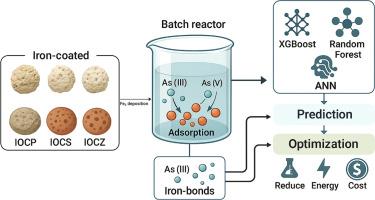利用氧化铁包覆的天然矿物可持续除砷:整合吸附、机器学习和工艺优化
IF 6.3
2区 材料科学
Q2 CHEMISTRY, PHYSICAL
引用次数: 0
摘要
我们研究了利用氧化铁包覆浮石(IOCP)、海泡石(IOCS)和沸石(IOCZ)结合机器学习(ML)和优化技术,从水中持续去除亚砷酸盐(As(III))和砷酸盐(As(V))。吸附动力学遵循伪二阶模型,而平衡数据最好由Langmuir和Sips等温线表示,表明化学吸附在非均质表面上。为了预测和优化性能,应用了人工神经网络(ANN)、极端梯度增强(XGBoost)和随机森林(RF),交叉验证结果表明,人工神经网络(ANN)的准确性更高(R2高达0.96,RMSE 20-40µg l-1)。将人工神经网络与遗传算法和贝叶斯优化相结合,确定了pH、接触时间和初始浓度的全局最优值,得到残留浓度为~ 8.1µg l-1 (IOCP-As(III))、~ 42µg l-1 (IOCS-As(III))和~ 1.7µg l-1 (IOCZ-As(III))、~ 1.3µg l-1 (IOCP-As(V))、~ 28µg l-1 (IOCS-As(V))和~ 6.2µg l-1 (IOCZ-As(V))。与试错条件(IOCS-As(III)的残差为~ 112 μ g l-1, IOCP-As(V)的残差为~ 27 μ g l-1)相比,优化后的系统减少了高达65%的化学品使用量,将处理成本降低至~ 0.004-0.007美元mg-1 As,并为IOCP-As(V)和IOCZ-As(III)带来了超过80%的积极环境收益。这些结果表明,当与人工智能驱动的优化相结合时,天然矿物基吸附剂可以以低成本和减少环境足迹的方式几乎完全去除As(III)和As(V),为可持续水处理提供了技术上强大且可扩展的框架。本文章由计算机程序翻译,如有差异,请以英文原文为准。

Sustainable arsenic removal using iron-oxide-coated natural minerals: Integrating adsorption, machine learning, and process optimization
We investigated the sustainable removal of arsenite (As(III)) and arsenate (As(V)) from water using iron oxide-coated pumice (IOCP), sepiolite (IOCS), and zeolite (IOCZ) integrated with machine learning (ML) and optimization techniques. Adsorption kinetics followed a pseudo-second-order model, while equilibrium data were best represented by Langmuir and Sips isotherms, indicating chemisorption on heterogeneous surfaces. To predict and optimize performance, Artificial Neural Networks (ANN), Extreme Gradient Boosting (XGBoost), and Random Forest (RF) were applied, with cross-validated results demonstrating the superior accuracy of ANN (R2 up to 0.96, RMSE 20–40 µg l-1). Coupling ANN with Genetic Algorithm and Bayesian Optimization identified global optima for pH, contact time, and initial concentration, yielding residual concentrations of ∼8.1 µg l-1 (IOCP-As(III)), ∼42 µg l-1 (IOCS-As(III)), and ∼1.7 µg l-1 (IOCZ-As(III)), and ∼1.3 µg l-1 (IOCP-As(V)), ∼28 µg l-1 (IOCS-As(V)), and ∼6.2 µg l-1 (IOCZ-As(V)). Compared with trial-and-error conditions (residuals of ∼112 µg l-1 for IOCS-As(III) and ∼27 µg l-1 for IOCP-As(V)), the optimized systems reduced chemical usage by up to 65 %, lowered treatment costs to ∼0.004–0.007 $ mg-1 As, and delivered positive environmental gains exceeding 80 % for IOCP-As(V) and IOCZ-As(III). These results demonstrate that natural mineral-based sorbents, when coupled with AI-driven optimization, can achieve near-complete removal of both As(III) and As(V) at low cost and with reduced environmental footprint, offering a technically robust and scalable framework for sustainable water treatment.
求助全文
通过发布文献求助,成功后即可免费获取论文全文。
去求助
来源期刊

Surfaces and Interfaces
Chemistry-General Chemistry
CiteScore
8.50
自引率
6.50%
发文量
753
审稿时长
35 days
期刊介绍:
The aim of the journal is to provide a respectful outlet for ''sound science'' papers in all research areas on surfaces and interfaces. We define sound science papers as papers that describe new and well-executed research, but that do not necessarily provide brand new insights or are merely a description of research results.
Surfaces and Interfaces publishes research papers in all fields of surface science which may not always find the right home on first submission to our Elsevier sister journals (Applied Surface, Surface and Coatings Technology, Thin Solid Films)
 求助内容:
求助内容: 应助结果提醒方式:
应助结果提醒方式:


